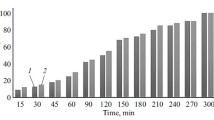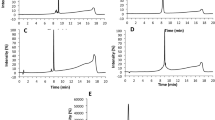Abstract
We used a modified protocol of the murine local lymph node assay (LLNA) to study the cross-sensitising potential of (a) textile dye disperse yellow 3 and its metabolite 2-amino-p-cresol, (b) two antibiotics, penicillin G and cefotiam. The test substances were applied in a biphasic manner, i.e. first on the shaved skin of the back followed by application on the dorsal side of the ears after 2 weeks. The end-points analysed included thickness and weight of an ear-biopsy, weight and cell number of the draining lymph node, and lymphocyte cell surface markers analysed by flow-cytometry. Disperse yellow 3 and its metabolite significantly altered the various end-points at both the tested concentrations (0.5 and 1%), thus demonstrating the sensitising potential of the two substances. The cross-sensitisation study showed significant modulation in the tested variables in the treated group as compared to the control, signifying cross-sensitisation potential of the two substances. Penicillin G and cefotiam showed significant changes in various end-points, pointing towards their sensitising potential. However, even at 50% concentration of the β-lactams no significant change in any end-point indicating absence of cross-reactivity of the antibiotics was noticed. We conclude that a biphasic, modified protocol of the LLNA is a suitable approach to test for a cross-reactivity potential of two related compounds.




Similar content being viewed by others
References
Adkinson NF, Essayan D, Gruchalla R, Haggerty H, Kawabata T, Sandler JD, Updyke L, Shear NH, Wierda D (2002) Task force report: future research needs for the prevention and management of immune-mediated drug hypersensitivity reactions. J Allergy Clin Immunol 109(3):S461–S478
Anne S, Reisman RE (1995) Risk of administering cephalosporin antibiotics to patients with histories of penicillin allergy. Ann Allergy Asthma Immunol 74:167–170
Baer R, Leider M (1949) The effects of feeding certified food azo-dyes in paraphenylenediamine-hypersensitive subjects. J Invest Dermatol 13:223–232
Botham PA, Basketter DA, Maurer T, Mueller D, Potokar M, Bontinck WJ (1991) Skin sensitization—a critical review of predictive test methods in animal and man. Food Chem Toxicol 29:275–286
Brandao FM, Altermatt C, Pecegueiro M, Bordalo O, Foussereau J (1985) Contact dermatitis to disperse blue 106. Contact Dermatits 13:80–84
Calnan CD (1976) Quinazoline yellow SS in cosmetics. Contact Dermatitis 2:160–166
Correia S, Brandao MF (1986) Contact dermatitis of the feet. Derm Beruf Umwelt 34:102–106
Cronin E (1980) Clothing and textiles. In: Contact dermatitis. Churchill Livingstone, London, pp 36–92
D’Cruz D (2000) Autoimmune diseases associated with drugs, chemicals and environmental factors. Toxicol Lett 112–113:421–432
Dooms-Goossens A, Bonamie A, Parys M, Dooms M (1981) Sensitizing anthraquinone dye in spectacle frames. Contact Dermatitis 7(4):214–215
Ehling G, Hecht M, Heusener A, Huesler J, Gamer AO, van Loveren H, Maurer T, Riecke K, Ullmann L, Ulrich P, Vandebriel R, Vohr HW (2005) An European inter-laboratory validation of alternative endpoints of the murine local lymph node assay: first round. Toxicology 212:60–68
Feinberg JG (1968) Allergy to antibiotics. I. Facts and conjecture on the sensitizing contaminants of penicillin and cephalosporins. Int Arch Allergy 33:439
Gielen K, Goossens A (2001) Occupational allergic contact dermatitis from drugs in healthcare workers. Contact Dermatitis 45(5):273–279
Grieco MH (1967) Cross-allergenicity of the penicillins and cephalosporins. Arch Intern Med 119:141
Guiraud-Pons A (1999) Aspects cliniques de l’allergie aux colorants des textiles. In: Progres en dermato-allergologie. John Libbey eurotext, Lyon, pp 151–161
Hariya T, Hatao M, Ichikawa H (1999) Development of a non-radioactive endpoint in a modified local lymph node assay. Food Chem Toxicol 37(1):87–93
Hatch KL, Maibach KI (1995) Textile dye dermatitis. J Am Acad Dermatol 32:631–639
Hatch KL, Motschi H, Maibach HI (2003) Textile-dye and colored-textile allergic contact dermatitis. Exog Dermatol 2:206–209
Homey B, von Schilling C, Blümel J, Schuppe HC, Ruzicka T, Ahr HJ, Lehmann P, Vohr HW (1998) An integrated model for the differentiation of chemical-induced allergic and irritant skin reactions. Toxicol Appl Pharmacol 153:83–94
Kabins SA, Eisenstein B, Cohen S (1965) Anaphylactic reaction to an initial dose of sodium cephalothin. J Am Med Assoc 193:165
Kelkar PS, Li JT (2001) Cephalosporin allergy. N Engl J Med 345:804–809
Kousa M, Soini M (1980) Contact allergy to a stocking dye. Contact Dermatitis 6:472–476
Ky NT, Chauvin MT, Pinon C, Halpern BN (1970) Positive immunologic reactions to cephaloridine in patients allergic to penicillin: a study performed with the lymphoblastic transformation test. Postgrad Med J 46:109S
Lepoittevin JP (1999) Chimie des colorants vestimentaires. In: Progres en dermato-allergologie. John Libbey eurotext, Lyon, pp 151–161
Michaelsson G, Juhlin L (1973) Urticaria induced by preservatives and dye additives in food and drugs. Br J Dermatol 88:525–532
Miller MM, Goldberg HS, Wilkerson WG (1978) Allergic contact dermatitis to 1,4-bis(isopropylamino)anthraquinone caused by a felt-tip marker pen. Arch Dermatol 114(2):1793–1794
Molthan L (1968) Screening test to confirm sensitivity to both penicillin and cephalothin. J Am Med Assoc 206:1701
Platzek T, Gi US, Lang C, Baltes W (1997) Azo dyes are split into aromatic amines by human skin bacteria in vitro. Naunyn Schmiedeberg Arch Pharmacol 356:R62
Pumphrey RS, Davis S (1999) Under-reporting of antibiotic anaphylaxis may put patients at risk. Lancet 353:117–1158
Rietschel RL, Fowler JF (2001) Textile and shoe dermatitis. In: Fisher’s contact dermatitis, 5th edn. Lippincott Williams & Wilkins, Philidelphia, pp 279–305
Sailstad DM (2002) Murine local lymph node assay: an alternative test method for skin hypersensitivity. Lab Anim 31:36–41
Schneirson SS, Perlman E, Shore B (1964) Cephalothin antigenicity and cross reactivity with penicillin G. Clin Med 71:1933–1937
Seidenari S, Mantovani L, Manzini BM, Pignatti M (1997) Cross-sensitization between azo dyes and para-amino compound. Contact Dermatitis 36:91–96
Sikorski EE, Gerberick GF, Ryan CA, Miller CM, Ridder GM (1996) Phenotypic analysis of lymphocyte subpopulations in lymph nodes draining the ear following exposure to contact allergens and irritants. Fundam Appl Toxicol 34(1):25–35
Smith J, Gawkrodger DJ (2002) Contact Dermatitis from textile and dye allergens requires high index of suspicion for diagnosis. Contact Dermatitis 47:112–113
Stahlmann R, Wegner M, Riecke K, Kruse M, Platzek T (2006) Sensitising potential of four textile dyes and some of their metabolites in a modified local lymph node assay. Toxicology 219:113–123
Stewart GT (1962) Cross-allergenicity of penicillin G and related substances. Lancet 1(7228):509–510
Stewart GT (1967) Hypersensitivity and toxicity of β-lactam antibiotics. Postgrad Med J S43:31–36
Suda A, Yamashita M, Tabei M, Taguchi K, Vohr H-W, Tsutsui N, Ritsuyoshi S, Katsuaki K, Sakaguchi K, Mochizuki K, Nakamura K (2002) Local lymph node assay with non-radioisotope alternative endpoints. J Tox Sci 27(3):205–218
Uetrecht JP (1999) New concepts in immunology relevant to idiosyncratic drug reactions: the “danger hypothesis” and innate immune system. Chem Res Toxicol 12:387–395
Ulrich P, Streich J, Suter W (2001) Intralaboratory validation of alternative endpoints in the murine local lymph node assay for the identification of contact allergic potential: primary ear skin irritation and ear-draining lymph node hyperplasia induced by topical chemicals. Arch Toxicol 74:733–744
Author information
Authors and Affiliations
Corresponding author
Rights and permissions
About this article
Cite this article
Ahuja, V., Schreiber, C., Platzek, T. et al. Investigation of the sensitising and cross-sensitising potential of textile dyes and β-lactam antibiotics using a biphasic mice local lymph node assay. Arch Toxicol 83, 691–699 (2009). https://doi.org/10.1007/s00204-009-0407-1
Received:
Accepted:
Published:
Issue Date:
DOI: https://doi.org/10.1007/s00204-009-0407-1




